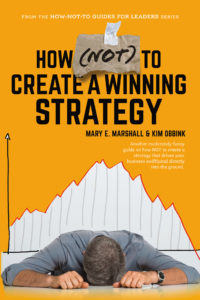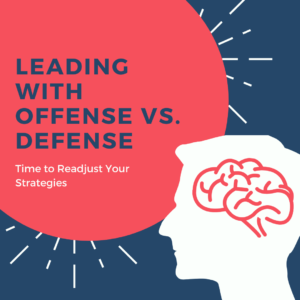Mary E. Marshall's Blog, page 11
October 27, 2020
The “How (NOT) to” Leadership Series Is Finally Here!
 When Kim Obbink and I first had the kernel of an idea to write a book, we were just riffing on all the bad leaders we had encountered in our careers. The stories were funny, tragic, and in some cases predictable. Then we started to see patterns and how we might use humor to share lessons in our stories.
When Kim Obbink and I first had the kernel of an idea to write a book, we were just riffing on all the bad leaders we had encountered in our careers. The stories were funny, tragic, and in some cases predictable. Then we started to see patterns and how we might use humor to share lessons in our stories.
We debated about launching the series during the pandemic and then realized that there’s no better time to share lessons about leadership, building teams and creating strategies, or “how NOT to” than during these times of crisis. Fortunately, our publisher agreed and now the series is available on Amazon.
How (NOT) to Be a Leader – Will show you how to avoid being the lonely leader with no one following. We’ll show you how to avoid the top 24 mistakes that keep leaders followerless.
How (NOT) to Build a Great Team – Unless you’re superman, you need a team if you want to get anything done. If you want to build a great team, we’ll show you the top 24 things NOT to do to get there.
How (NOT) to Create a Winning Strategy – Execution of a bad strategy still leaves you with a bad strategy. We’ll show you all the ways to avoid creating a bad strategy and how to create one that wins the day.
Today, leaders need to be resilient first and foremost, adaptable, and innovative. Our world has turned upside down and to lead you need to reach into your tool kit and dust off some of the skills that may have been on autopilot for a while and actively use them. People need leaders to show strength through patience, empathy, and understanding, not bravado, ego, and force of will. Truth not lies or fairy tales, and wisdom that knows how to create followership by standing for the successes of the people we lead.
Strategies have changed, opportunities are there if we open our eyes and remain flexible and adaptable. Create a few different ones depending upon your industry, your locations, and your team. Involve your team in the plan so it really becomes a collective enterprise – not just the dream of the smartest person in the room (who will usually remain alone!).
Building teams and momentum in times of crisis usually happens quickly and people are glad for the leadership and the ability to help. The challenge we currently face is not knowing when it will be over or what it will look like when it is. Navigating the uncertainty is hard, however, good leadership is the glue keeping it all together. You want to be able to cross the finish line with your team, not in front of them.
We hope these leadership lessons shared with humor will help give you perspective and support. Let us know what you think of our books on Amazon! We love reviews and they are much appreciated.
Enjoy the series and hopefully, you’ll take an idea or two of what (NOT) to do back to your team!
The post The “How (NOT) to” Leadership Series Is Finally Here! appeared first on Mary Marshall // CEO Coach.
October 21, 2020
How NOT to Create a Winning Strategy
 The Beauty in the Rearview Mirror?
The Beauty in the Rearview Mirror?
Wagging the Dog?
By Imitation Only?
Innovation Is for Losers?
Loyalty to Comrades?
The Impossible Divorce?
The last book in our series of “how-not-to guides,” “How NOT to Create a Winning Strategy,” is all about how NOT to create the plan. Leadership and teams (discussed in our first two guides) are meaningless without a strategy and tactical plan to make it happen.
Ever sat through a strategic planning session that was facilitated by an inept facilitator or, worse, a CEO who wasn’t sure what strategy was? Or possibly the worst, dragging out the old plan from previous years, dusting it off, making a couple of changes, and calling it good? These are just a couple of ways NOT to create a winning strategy. None of these will excite the team that needs to make the strategy happen.
The first reason strategies and strategic planning fail is that leaders don’t even know what a strategy is. They confuse it with a list of goals that need to be accomplished. Goals are good – but they’re even better when in service of a great strategy.
A strategy is a way to achieve something; it is a particular path you choose to go down to accomplish something that you or your organization what to achieve. Say you want to make a cake; there are multiple ways to do it. When you decide to go forward, you will pick a certain strategy to make the cake based on any number of factors. There will be various tasks and goals associated with those factors, and if you’re taking your cake to a bake sale, everyone will have used a different strategy to get their cake to market. Some will taste great; some will look great and some will be somewhere in the middle. You want your cake to be both and to be the winning cake.
Business strategies are – or should be – in service of a vision the organization has. Sometimes the bigger problem is the vision is really a mission, or strategic objectives are confused with goals and the result is a word salad that no one understands or cares about. You know you have a stinker of a plan when not a word is spoken about time well spent creating it.
These twenty-four priceless vignettes of hapless leadership and strategic planning will help you avoid the common mistakes and help you create a winning strategy, not one that is destined for the round file.
If you’re ready to find out how not to create a winning strategy, click here
The post How NOT to Create a Winning Strategy appeared first on Mary Marshall // CEO Coach.
October 14, 2020
How NOT to Build a Great Team
 Team Building for Toddlers?
Team Building for Toddlers?
Loyalty Is the New Cocaine?
Frat House Frenzy?
Titles Are Forever?
Type A Is for A$$hole?
Do any of these sound familiar? If so, you’ll probably find the new book I co-authored with Kim Obbink, “How NOT to Build a Great Team,” is for you. It’s the second in our series of three “How Not To” guides written to help leaders and managers avoid classic pitfalls.
This collection of funny, cautionary tales identifies patterns we have seen time and again during our years of leadership coaching. In this book, we provide examples of how teambuilding goes awry.
We believe that every business is a people business. It is the employees, the talented and skilled individuals, and teams that are the central nervous system of every business’s operations and strategy. Having great people allows leaders to keep their sights set on the day-to-day business itself. By doing so, they can focus on products, competitive strategies, sales, and innovation. If you are constantly churning around in the muck and mess of people and HR issues, the world outside the walls of your business will rush by you, and you’ll still be trying to figure out a way to fire Sam without hurting his or her feelings.
Dealing with people is not for the faint of heart. It is where the toughest conversations occur, the most complex interpersonal dynamics exist, and where you’ll be called upon to be a psychiatrist, HR professional, mediator, referee, umpire, teacher, and camp counselor. It is where you can do the most damage by making bad decisions, where the wrong people can have the most lasting negative impact, and where bad people quickly kill healthy company cultures.
It can also be the most rewarding. When you experience the positive impact that well-developed and well-managed people and teams have on your business, and when you witness the personal growth of the people you’ve hired, you’ve arrived at people management nirvana. You and your business will be rewarded with a happy culture, good employee retention, and a reputation that will attract top talent from across the industry. Plus, it will just feel good.
In this book, we address three critical aspects of developing a great team: hiring and firing, team management, and leadership development. We’ll share with you some real and some entirely made up stories about hiring the wrong people for the wrong reasons, how easy it is to create a dysfunctional team of do-nothings, and what to do when what was once your brilliant entrepreneurial vision suddenly turns into the lost chapter of Lord of the Flies.
Buckle up, leader. This is where the going gets tough. Luckily, you’ll have our guide to help you muddle through!
If you’re ready for more click here .
The post How NOT to Build a Great Team appeared first on Mary Marshall // CEO Coach.
October 7, 2020
How NOT to Be a Leader
 You’re the Smartest Person in the Room?
You’re the Smartest Person in the Room?
It’s All About You?
The Irrelevance of Truth?
Drop Your Integrity?
Winning the Blame Game?
Sound familiar? When my co-author Kim Obbink and I wrote this book, we didn’t have any specific leader in mind. Instead, we reflected on the overall patterns of bad leadership we had experienced during our years as business coaches to entrepreneurs. Time and again we noticed that leaders fell into the same traps and were bringing themselves down without even realizing it.
Our first guide, “How NOT to Be a Leader,” was written to help leaders avoid becoming “hated losers in the ivory tower” by their teams, or having to look in the rear-view mirror and wonder if that was the car wreck of their leadership road trip. In each chapter, we shine the spotlight on the oh-so-common mistakes that many leaders make while plowing forward through life and business without taking the time to really consider the effect they are having on others. We’ve all seen and heard the horror stories of bad leadership, and hopefully, many of you have been lucky enough to have been the benefactor of truly great leadership. Either way, if it’s your turn at the top, this book will help you understand what you can do to be a better leader by first understanding what you should never ever do; and if you are, why you should back up, and take another look at yourself and your leadership qualities, and do the work and self-reflection needed to get back on track.
We identify the twenty-four characteristics that you definitely don’t want to be known for. What was it you heard in your last 360? Micromanaging doesn’t work? You aren’t listening? You want everyone to do it your way? You might have a few to work on, so pick a couple, laugh with us, and learn a better approach.
As we have often found, you might not have the perfect self-awareness mirror on your wall so this book can help. You can also give the book to some of your peers or your direct reports and see which of the twenty-four characteristics they might identify as your areas to work on. Go ahead, you’ll be glad you did. And your direct reports will be even more excited about your transformation.
If you’re ready to find out How NOT to Be a Leader click here .
The post How NOT to Be a Leader appeared first on Mary Marshall // CEO Coach.
June 3, 2020
“Unlearning” to Create Change
 Racism is a learned set of beliefs and behaviors. We weren’t born believing that people with darker or different skin colors have less worth than those of lighter skin tones. We were taught that. It’s not true, but the false belief is driving horrific behaviors that have led to systemic racism in our culture and our lives. The result of which is playing out on the national stage convulsing an already frayed society.
Racism is a learned set of beliefs and behaviors. We weren’t born believing that people with darker or different skin colors have less worth than those of lighter skin tones. We were taught that. It’s not true, but the false belief is driving horrific behaviors that have led to systemic racism in our culture and our lives. The result of which is playing out on the national stage convulsing an already frayed society.
Values drive beliefs, beliefs drive behaviors, and behaviors drive results. I talk about this concept in my book, “The Great Culture Disconnect,” attributed to Simon Sinek. So, if behaviors are based on a false belief, can they be unlearned? The short answer is “yes.” Is it easy? NO. We must stop believing racism is inevitable – the clashes, the strife – and realize that all of it is based on a false premise. If it’s false, then my current behavior – blatant or unconscious racism – is also wrong. So, what do we replace this false belief with? The truth. Skin color does not make anyone a better or worse human being.
Can’t we look at each and every human being as different, unique, and beautiful? Can we replace the false belief of “better than/worse than” with the truth? How many repetitions of the true belief will it take for us to actually change behavior? 30. Research shows that any behavior, which has become a habit, can be changed by 30 repetitions, and catching the false belief we have that drives the behavior. Obviously, it may take a lot more than 30 repetitions – and you will need to believe it’s possible.
As leaders, we also need to take a look inside of our organizations. What conscious or unconscious beliefs may be inside our companies and teams that are contributing to systemic racism? A good place to start would be to open dialogues with your employees who are people of color. What is their perspective? What do they want? Can you build a plan of action for change collaboratively with them? Do you need to reach out to outside resources for help? What can you do as a collective to be agents for change? And if you don’t have any employees who are people of color, start by examining that.
Everyone can be a leader in this behavioral change – in fact, all of us will need to change in order for racism to be extinguished. It won’t happen quickly, and it will take one person at a time to lead the change. The cop who kneels with the protestor. The bystander who hugs the aggrieved victim and feels their pain. Peaceful protesters who ask for what they want changed, one leader at a time. We can only be truly responsible for our own behavior. Start with changing your own beliefs about racism and reframe anything that is false. Replace it with the truth. One by one we can all lead each other out of the horrific behaviors that have been created by our false beliefs.
Ending racism is possible and it’s up to each of us to work on ourselves and work collaboratively with people of color to make the changes that must happen. I know we will be there when no mother has to tell her children to behave differently because of these false beliefs. Black children will not be warned to keep their hands out of their pockets and to keep their hoodies down. Black men and boys will not be told to put their ID and registration in their car visors, so they are reaching up vs. down in a glove box when stopped by the police. Black and brown people will not have to worry about being shot in their own homes by police because of the assumption that they are in the wrong simply because of their skin color.
We all need to change our behavior. Start by reflecting on and recognizing your own false beliefs and start today.
The post “Unlearning” to Create Change appeared first on Mary Marshall // CEO Coach.
May 19, 2020
Leadership Support: 17 Tips for Challenging Times
 Most of us are overwhelmed right now. There’s a lot to consider, to plan for, and to address. I put together this list of leadership strategies based on what I see happening with my clients to offer you some support. Don’t expect to do them all at once. Pick a couple and try to use them for a few days and see if they help. If they’re working, add in a couple more. We can do this!
Most of us are overwhelmed right now. There’s a lot to consider, to plan for, and to address. I put together this list of leadership strategies based on what I see happening with my clients to offer you some support. Don’t expect to do them all at once. Pick a couple and try to use them for a few days and see if they help. If they’re working, add in a couple more. We can do this!
First, take care of yourself. Make sure you are doing all that helps you to maintain balance, including the things on this list.
Establish routines – both personal and professional. Routines help to ease anxiety about the unknown.
Don’t schedule more than 1.5 hours without a break. Science says our brains don’t function as well without it.
Use a combination of email, phone, and video (replacing in person) to create variety and break up the sameness.
Set weekly goals and a way to track them. Not anything big, more like a daily tracker for projects and tasks. Hold yourself accountable and encourage others to do the same.
When talking with employees, refrain from black and white thinking – “all or nothing,” keeps people in the neutral zone.
Discourage catastrophizing. Yes, the situation is not good, however, we can manage.
Sometimes playing out worst-case scenarios for people helps them understand that there is a way to handle it and plans can be made to mitigate it.
If your team members are fearful, ask questions to test the reality of those fears. Often fears are far worse than the actual situation.
Empathize with others but don’t encourage negative thinking. “I can understand how you might feel that way, what else have you thought about as an alternative,” can be a reframe.
Leave white space on your calendar, but with a note not to schedule you, at least 2-3 times per day. It’s your drive-by time to pick up the phone/face time and “visit” with anyone you feel like. A 5- or 10-minute pick me up to help you relax and reconnect.
Remember it’s okay not to be perfect. Perfection is an illusion anyway!
Listen, Listen, Listen. Don’t move to solve mode, listen to learn, and help others solve their own problems – with a little nudge sometimes.
Set aside 5 minutes at the end of every day for a self-debrief – what went well, what didn’t go well and what will you do differently tomorrow. No self-criticism, just a realistic look at the day and your participation in it. Don’t “should” on yourself.
Celebrate the small wins – home runs will be few and far between, (especially without baseball!), so just get on first base for now and acknowledge how good that is, because it is.
Mistakes happen, failures lead to better outcomes. Without them, we would have no idea how to create and innovate.
The burden of the world is not on your shoulders. No one can solve anything completely alone. We can only make it better together.
I hope these strategies will support your leadership during these challenging times.
The post Leadership Support: 17 Tips for Challenging Times appeared first on Mary Marshall // CEO Coach.
May 7, 2020
Leading with Offense vs. Defense – Time to Readjust Your Strategies
 I recently had the opportunity to chat with Amy Hedin, the CEO and an executive coach at Human Point on her blogging podcast, “Coaching Coffee Break,” about how organizations should look at their strategic plans given the current realities of our new COVID-19 world.
I recently had the opportunity to chat with Amy Hedin, the CEO and an executive coach at Human Point on her blogging podcast, “Coaching Coffee Break,” about how organizations should look at their strategic plans given the current realities of our new COVID-19 world.
Bottom line, you need to shift your strategy to one that plays more offense than defense. If you remain on defense, you’ll be protecting that which might not ever exist again. As I discussed in my last blog, “Leading Into the Unknown,” there will be plenty of opportunities, but if you remain in the “protect” or defensive mode of what you started the year out with, you’ll miss them. And you’ll be defending a castle whose foundation has permanently shifted – and possibly not for the better.
So, does this mean that all your hard work, all your ideas, and all your strategic goals need to be thrown by the wayside? Of course not, but the future looks completely different than it did 6 months ago. Remember that when you do a SWOT (Strengths, Weaknesses, Opportunities, Threats), the S and W are internal, and the O and T are external. We just had a MAJOR external Threat that upended everything – our employees, our customers, and our way of life. Which means even those who had planned for some sort of a major threat to their business, may not have been fully prepared for the impact of a major pandemic.
Just look at our government with all the resources at their disposal. They were unable to use the plan to their advantage and we are now seeing the consequences of that playing out. Trying to make yesterday come back is not going to make it so. There are no magic ruby slippers.
What you can do is play offense. Consider what opportunities have sprouted since the pandemic took hold? The following reflection questions will help you:
How are our competitors doing? Are their merger opportunities?
Now that we know people can work from home successfully, what does that mean for our workforce? Our locations? Our customers?
What products do we need to create based on different needs than 6 months ago?
How are clients/customers going to use our products or services differently than before?
How are they going to make buying decisions?
What does this mean for my organization structure?
What infrastructure will I need or not?
These are just some of the ways you can rewrite your strategies so that they are iterative and agile – the plan is almost obsolete the minute you finish it. As someone once said, it’s the planning, not the plan that’s important. Keeping it alive, fresh, relevant and most importantly in front of you is what matters. Predicting the future has never been easy, but those who are willing to change, to reinvent, to evolve and to innovate are the ones who will win at offense every time.
The post Leading with Offense vs. Defense – Time to Readjust Your Strategies appeared first on Mary Marshall // CEO Coach.
April 22, 2020
Leading Into the Unknown
 Leading a team or an organization today is difficult, to say the least. We are in uncharted water and so the destination is not fixed. There is no map and we don’t know what lies on the other side. So how on earth do you lead with confidence? The answer is you don’t, you lead with authenticity.
Leading a team or an organization today is difficult, to say the least. We are in uncharted water and so the destination is not fixed. There is no map and we don’t know what lies on the other side. So how on earth do you lead with confidence? The answer is you don’t, you lead with authenticity.
Authentic leaders know that you don’t have to have all the answers, you never will. What you must have is emotional intelligence based on self-awareness about what your strengths are as well as your weaknesses. And rather than hide the weaknesses, you will need to admit those, ask for help and surround yourself with people who can fill those gaps for you.
Authentic leaders are vulnerable, admit when they are wrong, and encourage others to step up. Teams will come through this situation, individual leaders who believe “they alone can solve this” will fail. This is not an individual sport, it’s a team effort. Much like an orchestra that produces beautiful music, it is the sum of the parts. The conductor knows how to coax the sound of the right musician and her instrument at the right time. It’s your job as a leader to step aside and let others play a part even if it’s new for them.
Part of leadership requires that you evaluate various strategies to navigate towards the vision, which means you must have a vision of the future that doesn’t exist today. That vision doesn’t need to be perfect, but it has to be something compelling that inspires hope in a better future. That vision should be shared by your leadership team and subsequently the entire organization – otherwise, the strategies selected to get you there will be disconnected from that vision. Don’t let the perfect get in the way of the good. We aren’t going back to where we were, but we can create a different and better future. The leaders’ job is to help everyone see the possibilities and engage the team in the journey.
You won’t know all the obstacles that you will face navigating through this crisis, let alone what the actual future will look like. However, your job is to give your team a glimpse of what it could be – your “what if” moment. Your job is to help them feel safe, give them confidence, and help them understand they are not alone and mean it. What you can know is that you have survived before and you will again – but only if you journey together. None of us will get through this by ourselves. The opportunities are greater than the obstacles. Your job is to help everyone believe that before they see proof of it.
Are you ready to be an authentic leader? Now is the time for your leadership and being a little unsure, a little afraid, and a little out of your depth means you’re right where you should be.
The post Leading Into the Unknown appeared first on Mary Marshall // CEO Coach.
April 7, 2020
How to Navigate the SBA Disaster Relief Programs
 We’re in a different world than we were a month ago and our business and personal lives have been upended. As with any seismic event that changes us, our outlook, and our opportunities we look for ways to navigate through it. The first phase of change is always the worst – shock, denial, grief – are all common reactions. The second phase is the navigating, trying to adjust to the new reality, predicting the future, and creating strategies that might work. The last phase is the new normal. As the corona virus outbreak was an unexpected event, we didn’t have time to do any planning in phase one, and apparently neither did our government.
We’re in a different world than we were a month ago and our business and personal lives have been upended. As with any seismic event that changes us, our outlook, and our opportunities we look for ways to navigate through it. The first phase of change is always the worst – shock, denial, grief – are all common reactions. The second phase is the navigating, trying to adjust to the new reality, predicting the future, and creating strategies that might work. The last phase is the new normal. As the corona virus outbreak was an unexpected event, we didn’t have time to do any planning in phase one, and apparently neither did our government.
However, the US Small Business Administration has come up with some help for all small businesses, those with less than 500 employees, and all small businesses will qualify for at least one or more of the programs.
Click here for the link to the four programs available for small business financial relief.
Let me give you a quick rundown on the programs to help sort through the clutter.
Paycheck Protection Program
This helps all small businesses keep or rehire employees, up to $10M per small business. It’s a loan but will be forgivable if you keep those employees on, and don’t lay them off before the end of the period. Even if you have to let some go, it’s pro-rated. If you’ve already laid off your employees, you can base it on what your payroll will be when you rehire them – which you will have to do, or the money will need to be repaid. Of the total amount you get, 75% will be for payroll and 25% can go towards, rent, interest and other various expenses to keep you in business. You must apply through your bank. This program was opened up on April 3rd. Be sure to check with your bank to see if they are participating. Most big banks like Chase and Wells Fargo are in the program. Click here for an additional list from the SBA for the Puget Sound area. It’s unlikely that you will be able to get a new bank to take you on right now as they will be too busy taking their existing clients.
Independent Contractors and Self-Employed individuals will also be able to apply for this – to cover your own salary starting April 10th.
EIDLA – Economic Injury Disaster Loan Advance
Directly from the SBA – this provides up to $10,000 per business, independent contractor or self-employed individual as an advance and is likely to be forgiven. It appears it’s more of a grant and you can apply now, everyone should apply for this asap.
You can apply for this loan by clicking here.
SBA Debt Relief
This is 6 months of debt relief for new and current SBA backed loans. Check with your lender to see if you qualify. New loans will be hard to get but if you need one and qualify, please try. Click here for information.
Express Bridge Loan
This provides up to $25K in advance of and SBA Debt Relief loan. While you wait for the bank to approve your debt relief, they will advance you $25K. Supposedly faster than waiting for the previous approval.
Most of these programs are first-come, first-served so please get your applications in as soon as possible and don’t worry about whether you qualify or not right now. The first two programs are direct relief for small businesses, and it appears will likely be forgiven or more like grants vs. loans.
For more information on this program click here .
The post How to Navigate the SBA Disaster Relief Programs appeared first on Mary Marshall // CEO Coach.
March 18, 2020
How (NOT) to Be a Leader – Virus Edition
 Kim Obbink and I co-wrote a book published in 2018, “How NOT to Be a Leader.” We just finished the 3-book series including, “How NOT to Build a Great Team” and “How NOT to Create a Winning Strategy,” which will be out in late spring or early summer of 2020.
Kim Obbink and I co-wrote a book published in 2018, “How NOT to Be a Leader.” We just finished the 3-book series including, “How NOT to Build a Great Team” and “How NOT to Create a Winning Strategy,” which will be out in late spring or early summer of 2020.
We thought it was a good idea to create a new chapter for our first book given the current situation. The concept for this book series is sharing tongue-in-cheek leadership lessons. Look to the bottom of each chapter for what we really think. In this unprecedented time, it’s good to smile, even for just a few minutes. We hope this will help you do that.
Rules for Leaders During a Pandemic
(taken from scribblings and scratchings of Great and Bigly Leaders)
Rule #1 – DENY, DENY, DENY
The first thing you have to realize is that YOU create the narrative, don’t let it be created for you, create it yourself! In the face of overwhelming evidence that this might be a big deal, call it fake news. Remember, you’re in charge so whatever you say is the truth until you decide it isn’t. That’s when you deny you ever said anything of the sort. Works every time. Bald-faced lying will never be questioned by a powerful leader so use it.
Rule #2 – Ignore the Eggheads
OK, let’s be clear, you’re in charge, not all the experts. Yeah, yeah, they have opinions, but we all know what those are worth, everyone has one. You are the elected or anointed leader, not them, so what you say goes, not their supposed expertise. Trust your gut instinct, even if you have absolutely no idea what they are talking about, pretend you do. It’s important not to give up your leadership cred to the elites and intellectuals.
Rule #3 – Find a Scapegoat
Remember, this could go south so you want some plausibility in denying you are in charge or that you made a bad decision. So, step back and find your biggest sycophant to be the head douche or spokesperson in case you have to blame someone. However, never stop taking credit for anything that goes well, after all, you’re the leader, right?
Rule #4 – Prevent Accurate Data at all Costs
If there is something that might out your position as wrong, such as testing, make sure you do everything to throw a spanner in that crankshaft so the numbers never show up against you. As the leader, be sure only those things that support your position are deemed credible and if something like testing or numbers might debunk your narrative, avoid them at all costs. You’re in charge, make it happen.
Rule # 5 – Surround Yourself with Idiots
Much like the scapegoat, you’ve got to have people around you that are dumber than you – which is easy as it’s almost everyone. This way they won’t question you and they’ll constantly tell you how great and smart you are and you need that boost in the face of a crisis. Be sure to fire anyone who gets too uppity and questions you. They have to go immediately.
Rule #6 – Do a 180 When All of the above Fail
As with most things, your position needs to be fluid when it looks like all the evidence is turning against your position. Get in front of it and act like you’re taking charge and that this was your plan all along. Use rule #1 (Deny) and rule #3 (Blame and Scapegoat) to get yourself out of it. Never, ever admit you were wrong, that is the kiss of death. Blame any of your previous statements on the idiots who work for you, the media, or your scapegoat. It’s important to get back in front, take credit for anything that is going well and blame everything else on anyone else but you.
Let’s Get Real
This is NOT how a leader handles a crisis. Do the opposite of every one of these rules. Leaders should defer to the experts. No one can be an expert at everything. Good leadership means surrounding yourself with the best and brightest, not your relatives, the dumbest, or the most sycophantic.
Be real in your communication. If you don’t know something, say so. Explain how you will find out. Empathize with your followers. Try to understand what they might be going through. Show some humanity that you understand their struggles. It’s not just about the money, it’s about people’s livelihoods.
Ask people to join you in solutions. Don’t act as if you alone know it all. You don’t. People are so willing to band together and help, let them. Solutions come from the most surprising places.
Own your responsibility – as the leader, the buck stops with you and you alone. Trust is built from knowing that you have someone’s back, not that you are crawling over it to get out of the crisis.
Communicate frequently, even it’s bad news. Let the experts explain things but let people know that you’ve got this, for better or for worse.
Leaders who manage the crisis well for their people and their organizations will be remembered as great leaders, those who don’t will be forgotten or worse, held up as what NOT to do.
The post How (NOT) to Be a Leader – Virus Edition appeared first on Mary Marshall // CEO Coach.



